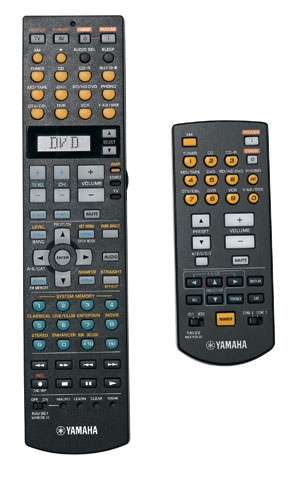Yamaha RX-V1800 A/V Receiver Page 3
 I did experiment with a pair of Mirage NanoSats as front presence speakers, and I found the DSP sound fields to be highly effective - although the success of the processing depended a lot on the program material. With simple recordings like the choral Sacred Feast SACD, I found I could use the DSP to re-create a space from the stereo tracks that in some ways rivaled the natural sound field recorded on the multichannel layer. In any case, it was great fun playing with the numerous variables that you can adjust within each sound-field mode.
I did experiment with a pair of Mirage NanoSats as front presence speakers, and I found the DSP sound fields to be highly effective - although the success of the processing depended a lot on the program material. With simple recordings like the choral Sacred Feast SACD, I found I could use the DSP to re-create a space from the stereo tracks that in some ways rivaled the natural sound field recorded on the multichannel layer. In any case, it was great fun playing with the numerous variables that you can adjust within each sound-field mode.
To check out the built-in Anchor Bay ABT1010 video scaler, I set my DVD player to deliver a 480i signal and connected the receiver's HDMI output to both my Sony 1080i-capable XBR direct-view CRT and a 1080p-capable Samsung DLP display. In both cases, the resulting image was exceptionally smooth and artifact-free, passing the adaptive motion tests on the Silicon Optics HQV test disc with flying colors. With my older Sony 1080i display, scaling the signal in the receiver was a notable improvement over the processing in either the DVD player or the display itself, delivering a particularly smooth yet detailed image. I even tried an old VHS VCR connected by composite video, and I got results that were decent (if, predictably, somewhat soft-looking).
When I finally sat down to watch a movie DVD, I couldn't find fault with the receiver's performance with Over the Hedge, a fine test of real-world dynamics and amplifier control. Even with everything but the rear surround speakers set to large, there always seemed to be plenty of power and headroom, and no sign that I was about to run out of steam.
Ergonomics Rather than going with some fancy-schmancy touchscreen control that's tougher to navigate than a Tokyo suburb, Yamaha has stuck with the basics: a straightforward multi-key remote. A three-way thumb switch on the side gives many of the buttons triple functions, and you'll have to flick it back and forth between "amp" and "source" quite a lot depending on what you're trying to do. Other components can be controlled either by using the built-in databank of codes or - if the one for your circa 1983 European VCR doesn't happen to be there - by learning directly from the component's remote.
The onscreen menus and displays are available on all video outputs, although their chunky block letters and white, triangular cursor are rather old-fashioned in this age of swanky-looking graphical user interfaces. (I even found a couple of typos in the text.) Still, they get the job done, and I discovered it was fairly easy and intuitive to find my way around without having to consult the 141-page manual too often.
Bottom Line The real news is that Yamaha has been able to deliver a midprice receiver that just about does it all, delivering superb overall performance without any glaring failures that need to be explained away. That's pretty rare with today's constantly evolving requirements. The RX-V1800 isn't perfect - more-flexible bass management would certainly be nice - but it does succeed in hitting almost everything right on target. If Yamaha were shooting ducks at the carnival, I'd award it a big stuffed teddy bear.
Full Lab Results Test Reports RSS Feed More Test Reports Back to Homepage What's New on S&V













































